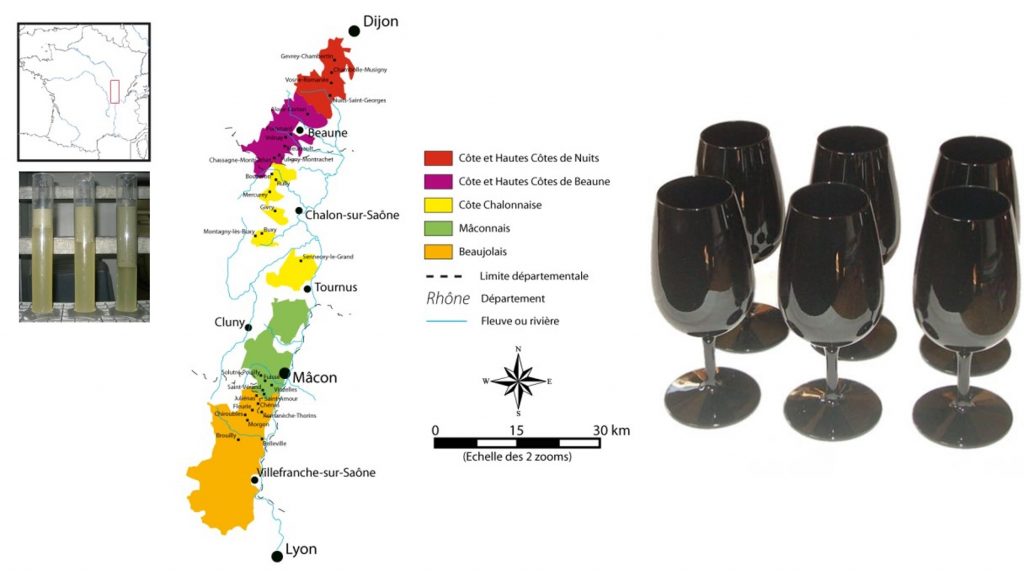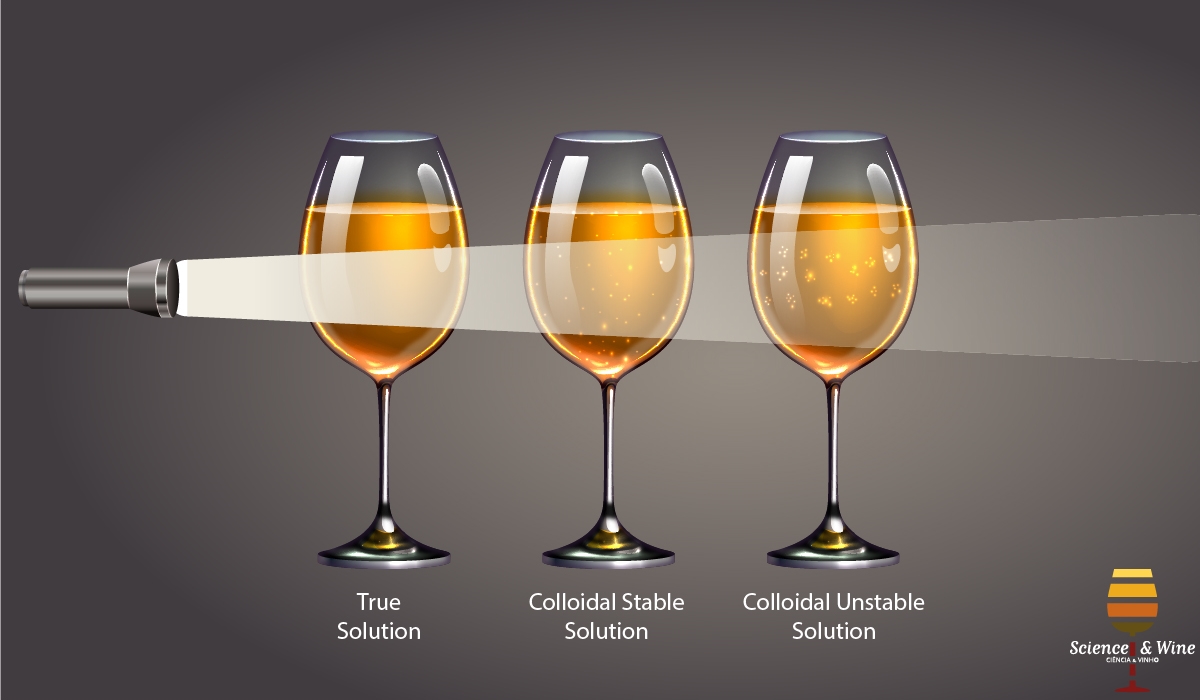By Christian Coelho
Wine contains many types of colloidal substances, which must be considered by winemakers in their decisions related to wine production (must racking, lees sedimentation, filterability, wood ageing) and wine stability (tartaric precipitations, protein hazes, colour stability, ageability). Some of them, such as tannins and polysaccharides, are also known to contribute to the final sensorial perception of wines particularly regarding astringency, bitterness and smoothness (Vidal et al., 2004). Indigenous colloids can be naturally extracted from grape and their concentration, after harvesting and pressing, are totally dependent of grape variety and maturity, and of pressing or the maceration pre-fermentative steps (Paetzold et al., 1990, Nunan et al, 2001). After must fermentation, the colloidal composition of wine is totally rearranged due to the metabolic activity of microorganisms’ consortiums and particularly species like Saccharomyces cerevisae, Oenococcus oeni and Lactobacillus Plantarum. Nowadays, the contribution of non-Saccharomyces yeasts to the wine composition is a study area in expansion (Simonin et al. 2018). The type of wine ageing (lees ageing, wood ageing) also confers a non-negligible colloidal fraction that contribute to the organoleptic perceptions of wines, and the ageability of wines (Dubourdieu et al., 1998).

Indigenous wine colloids are still poorly investigated due to lack of routinely implemented methodologies for their identification and characterization and because of the interferences that could occur from exogeneous macromolecular additives that are added to wine for better control of fermentation and clarification steps. Nevertheless, modern analytical tools are nowadays deployed to the scientific community that should show the functional role, particularly in wine ageability, of these wine colloids taking in account the wine molecular composition (Coelho et al., 2017, Roullier-Gall et al., 2017) By analysing wines, several years after storage in a cellar or in the deep sea, interesting archeo messages are revealed by wine (Gougeon et al., 2009, Jeandet et al., 2015, Coelho et al. 2015) revealing oenological practices that were applied during wine production in a specific vintage.

Two recent studies, carried by researchers at Institut Universitaire de la Vigne et du Vin, University of Burgundy (Ballester et al., 2018 and Coelho et al. 2018), estimated the impact of must clarification and the type of bottle closure during two consecutive vintages (2009 and 2010) on Chardonnay white wines organoleptic quality and chemical composition. Outstanding results from an oenological point of view show that the oldest vintage 2009 was more stable during bottle ageing compared to vintage 2010 due to molecular and macromolecular conditions gathered during this vintage, which were directly related to pre-fermentative decisions and bottling conditions. Globally, the low turbidity musts led to higher amount and diversity of the protein fraction and higher concentrations of oxidizable polyphenols such as grape reaction product and tyrosol in Chardonnay dry white wines presenting higher resistance to oxidative deviations.
The bottle closure, and particularly the synthetic coextruded stopper, was a key indicator of oxidative processes occurring during bottle storage, unlike screw caps preserved wine freshness and fruity/floral character. Even if the antioxidant role of proteins to protect wine oxidizable compounds was not proved, a quantitative proteomic study suggests putative candidates to this preservation action such as low-temperature induced cysteine proteinase-like, an unnamed protein product, basic leucine zipper, W2 domain-containing protein, structural maintenance of chromosomes protein 4 isoform X2 and elongation factor 1-alpha. On the opposite, two grape proteins: a hypothetical protein VITISV 024840 and actin-1 could participate to oxidative reactions during bottle ageing.
These recent encouraging progresses bring new insights to the functionalities that indigenous wine proteins could confer to Burgundian Chardonnay wines with elevated ageing potential.
Those interested in a longer length report can download the working paper at:
https://www.frontiersin.org/articles/10.3389/fchem.2018.00095/full

Christian Coelho studied physical-chemistry at University Blaise Pascal at Clermont Ferrand (France) and environmental chemistry at University Paul Sabatier in Toulouse (France). He did his Ph.D. in 2009 in photochemical processes related to dissolved organic matter optical properties and reactivity and worked between 2011 and 2012 in the fields of UV-absorbing nanomaterials as a research assistant at Ecole Nationale Supérieure de Chimie de Clermont-Ferrand (France). He joined Professor R. Gougeon team in September 2012 as an Assistant Professor in Oenology at the Institut Universitaire de la Vigne et du Vin – Jules Guyot, where he taught analytical chemistry oenological practices, grape maturity and spirit elaboration process. He is in charge of the first year of Diplome National d’Oenologue since 2017. He also realized two videos for the MOOC Open Wine University 1 and 2 (University of Burgundy) and a webinar for Horiba Scientific Company.
His research activity is focused on novel developments in the application of fluorescence, electron spin resonance and high-resolution mass spectrometry and molecular/macromolecular separations (size exclusion chromatography & flow field-flow fractionation) to determine the molecular and macromolecular compounds that are conferred to spirit and wine during their elaboration, storage and ageing. He also co-supervised a Ph.D in wine microbiology looking at the physical and chemical interactions between Oenococcus Oeni and wood during wine barrel ageing. He is currently supervising a Ph.D on the isolation, purification and fractionation of extracellular polymeric compounds secreted by Lactobacillus Plantarum to determine their functional properties at the wood/wine interface.
References
- Vidal S., Francis L., Williams P., Kwiatkowski M., Gawel R., Cheynier V., Waters E. The mouth-feel properties of polysaccharides and anthocyanins in a wine like medium. Food Chemistry (2004) 85: 519-525.
- Paetzold M., Dulau L., Dubourdieu D. Fractionnement et caractérisation des glycoproteins dans les moûts de raisin blanc. Journal International des Sciences de la Vigne et du Vin (1990) 24(1): 13-28.
- Nunan K., Davies C., Robinson D.P., Fincher G. Expression patterns of cell wall-modifying enzymes during grape berry development. Planta (2001) 214: 257-264.
- Simonin S., Alexandre H., Nikolantonaki M., Coelho C., Tourdot-Maréchal R. Inoculation of Torulaspora delbrueckii as a bio-protection agent in winemaking. Food Research International (2018) 107: 451-461.
- Dubourdieu, D., Moine-Ledoux, V., Lavigne-Cruège, V., Blanchard, L., and Tominaga, T. (2000) Recent advances in white wine aging: The key role of lees. In: Proceedings of the ASEV 50th Anniversary Annual Meeting, Seattle, WA, June 19–23, 2000, pp. 345–352. American Society for Enology and Viticulture, Davis, CA.
- Coelho C., Parot J., Gonsior M., Nikolantonaki M., Schmitt-Kopplin, P. Parlanti E., Gougeon, R.D. Asymmetrical flow field-flow fractionation of white wine chromophoric colloidal matter. Analytical and Bioanalytical Chemistry (2017), 409(10), 2757-2766.
- Roullier-Gall C., Hemmler D., Gonsior M., Li Y., Nikolantonaki M., Aron A., Coelho C., Gougeon R.D., Schmitt-Kopplin P. Sulfites and the wine metabolome. Food Chemistry (2017) 237, 106–113.
- Gougeon R.D., Lucio M., De Boel A., Frommberger M., Hertkorn N., Peyron D., Chassagne D., Feuillat F., Cayot P., Voilley A., Gebefügi I., Schmitt-Kopplin P. Expressing forest origins in the chemical composition of cooperage oak woods and corresponding wines by using FTICRS-MS. Chemistry A European Journal (2009) 15, 600-611.
- Jeandet P., Heinzmann S., Roullier-Gall C., Cilindre C., Aron A., Deville M.A., Moritz F., Karbowiak T., Demarville D., Brun C., Moreau F., Michalke B., Liger-Belair G., Witting M., Lucio M., Steyer D., Gougeon R.D., and Schmitt-Kopplin P. (2015) Chemical messages in 170-year-old champagne bottles from the Baltic Sea: Revealing tastes from the past. Proceedings of the National Academy of Sciences of the United States of America (2015) 112(19) 5893-5898.
- Coelho C., Aron A., Roullier-Gall C., Gonsior M., Schmitt-Kopplin P., Gougeon R.D. Fluorescence fingerprinting of bottled white wines can reveal memories related to sulfur dioxide treatments of the must. Anaytical Chemistry (2015) 87(16), 8132-81375
- Ballester J., Magne M., Julien P., Noret, L, Nikolantonaki M., Coelho C., Gougeon, R.D. Sensory impact of polyphenolic composition on the oxidative notes of Chardonnay wines. Beverages (2018) 4(1), 19.
- Coelho C., Julien P., Nikolantonaki M., Noret, L., Magne M., Ballester, J., Gougeon R.D. Molecular and macromolecular changes in bottle-aged white wines reflect oxidative evolution- Impact of must clarification and bottle closure. Frontiers in Chemistry (2018) 6 (95), 1-9.

